Department of Computer Science and Computing technology
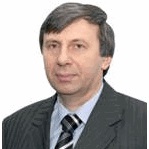
Considering the new circumstances, in order to prepare computer science teachers, by decision of the Higher Education Ministry from Chisinau, at the State Pedagogical Institute of Tiraspol (SPIT), on 15 October 1985, in the Faculty of Physics and Mathematics, the first Department of Computer Science and Computing Technology in the former USSR was established.
1. Computer Science development from the perspective of Mathematics
Computer science was built and developed as a science from mathematics. Therefore, the term computer science has its origin and comes from the combination of the word’s information and mathematics. In this way, the history of computer science begins before the invention of the computer.
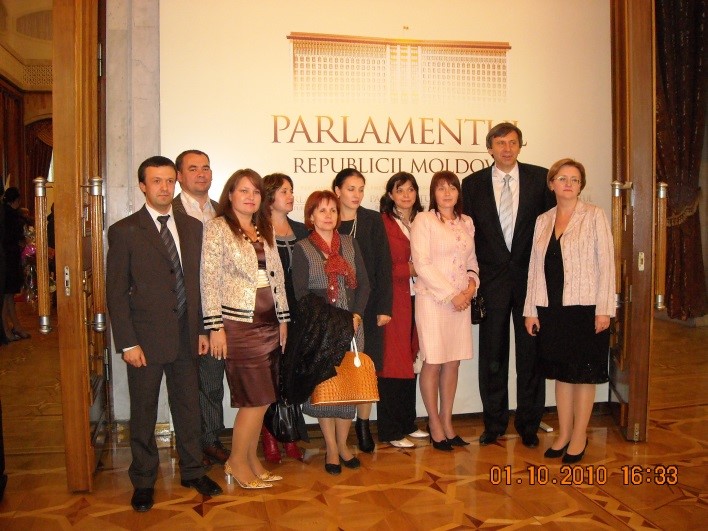
As a science, computer science, similar to mathematics, has implications and applications in all scientific, economic and social fields. It is not without reason that if mathematics is understood as “a logical system of formal thought”, then computer science, as a science, focuses specifically on what is feasible and can be accepted in computer language, in other words on “a logical and formal feasible system”. Computer science (in French “Informatique”) is the science of methods and processes of collecting, storing, processing, transmitting, analysing, and evaluating information using information technologies and computers, creating and providing the possibility of making correct decisions. The establishment and development of the theoretical basis of computer science have been decisively influenced by the ideas of Gottfried Leibniz, Ada Lovelace, Charles Babbage, George Bull, Samuel Morse, Alan Turing, Norbert Wiener, Claude Shannon, and others.
2. Development of computer science in the USSR The Bessarabian traces
The isolation of the former Soviet Union, caused by the socio-political events of the 20th century and the excessive ideologization of the real sciences has led to the development of processing, storage, analysis and information transmission sciences (cybernetics, computer science, bionics, etc.) has not been as productive and efficient as in Western countries. Nevertheless, the ideas generated and the results achieved by European and American scientists in the field of cybernetics, computer science, and, computer development have paved the way for the 1950s in the former USSR to implement successfully implement-ted the first projects in these fields.
Electronic computers of that time were created and launched in the most prestigious universities in the USSR. In the 1950s and 1970s in the USSR, high-performance computers for that period were created (МЭСМ, М-1, БЭСМ, EC ЭВМ, НАИРИ, Электроника, etc.) which were used at major industrial enterprises, research institutions, etc. Among the Soviet scientists who contributed to the development of cybernetics, computer science, and computing technology, one can name M. A. Lavrentiev, S. A. Lebedev, V. M. Glushkov, A.P. Ershov, E. Grebenicov, and others. One of the great Soviet mathematicians of Romanian origin, Eugeniu Grebenicov, born in the village of Slobozia Mare, Cahul County, made an important contribution to the development of cybernetics, computer science, and computing technology in the former USSR. Between 1969 and 1978 he was head of the Department of Cybernetics at the Moscow Institute of Electronics. From 1978-1988 – worked as Director of the Computing Centre of M.V. Lomonosov Moscow State University, the largest and most influential higher educational institution in the USSR. From 1986-1996 he worked as the scientific director of the Institute of Computing Techniques of the Russian Academy of Sciences.
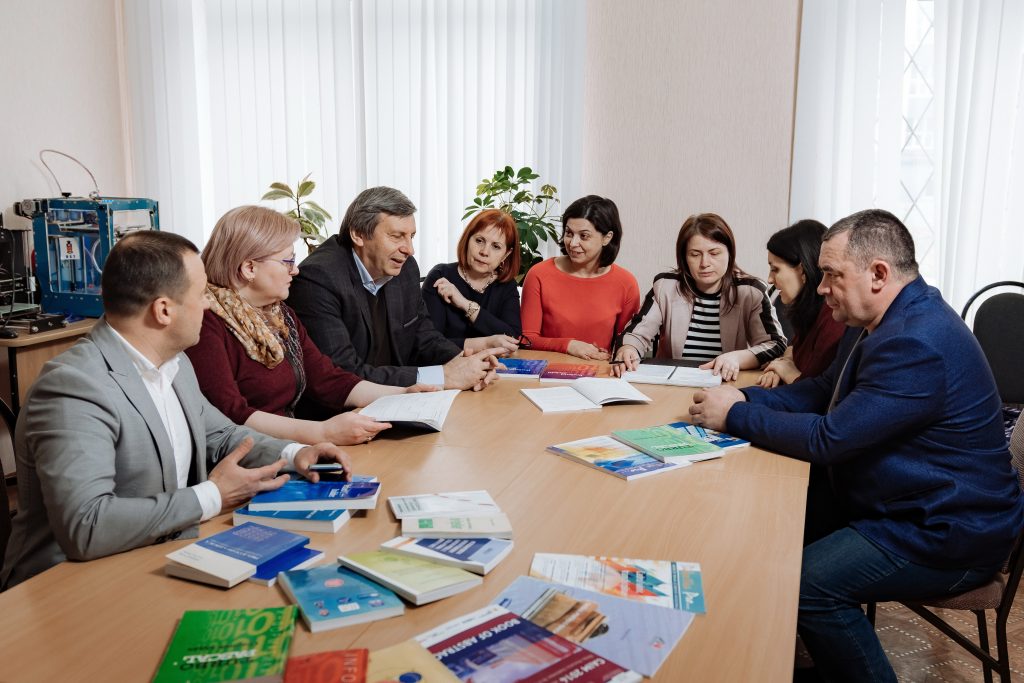
Since 1996, Professor E. Grebenicov has worked both at the University of Siedlce, Poland, and at the Department of Nonlinear Analysis and security problems of the Russian Academy of Sciences. Professor E. Grebenicov had a significant influence on the professional careers of Moldovan students studying at M.V. Lomonosov Moscow State Univer-sity in the field of fundamental mathematics, computing mathematics, mechanics, etc. In the context of that time, many of the Moldovan students of that period, Mitrofan Cioban, Iulian Marcov, Boris Morcov, Chiril Prisăcaru, etc., formed their opinions and views on science and research, cybernetics, computer science, and computing technology, including under the influence of the great scientist.
With the development of the personal computer market and the Internet in the 1980s, and in connection with the crisis of the socialist economy, Computer Science in the former USSR is gradually integrated into the international scientific circuit. Thus, in 1985, in schools in the USSR a new subject “Computer Science” was introduced and the first textbook on computer science, “Basics of Computer Science and Computer Technology”, was published under the editorship of A.P. Ershov. It was necessary to create a new scientific and educational infrastructure for the development of computer science. Thus, it started.
3. Establishment of the Department of Computer Science and Computing Technology
Considering the new circumstances, in order to prepare computer science teachers, by decision of the Higher Education Ministry from Chisinau, at the State Pedagogical Institute of Tiraspol (SPIT), on 15 October 1985, in the Faculty of Physics and Mathematics, the first Department of Computer Science and Computing Technology in the former USSR was established.
Through the order issued by Andrei Hariton, PhD, professor, rector of SPIT, in the year 1985, Iulian Marcov, PhD in Mathematical Sciences, Associate Professor, was appointed Head of the Department of Computer Science and Computing Technology (CSCT).
Professor Iulian B. Marcov was one of the few researchers at that time in Moldova who knew the field, and who received basic scientific training at the Moscow University and shared great Professor E. Grebenicov’s visions on the development and teaching of computer science. From this point of view, the ITC department had a good start and a well-thought-out and tenaciously implemented scientific-methodical development strategy.
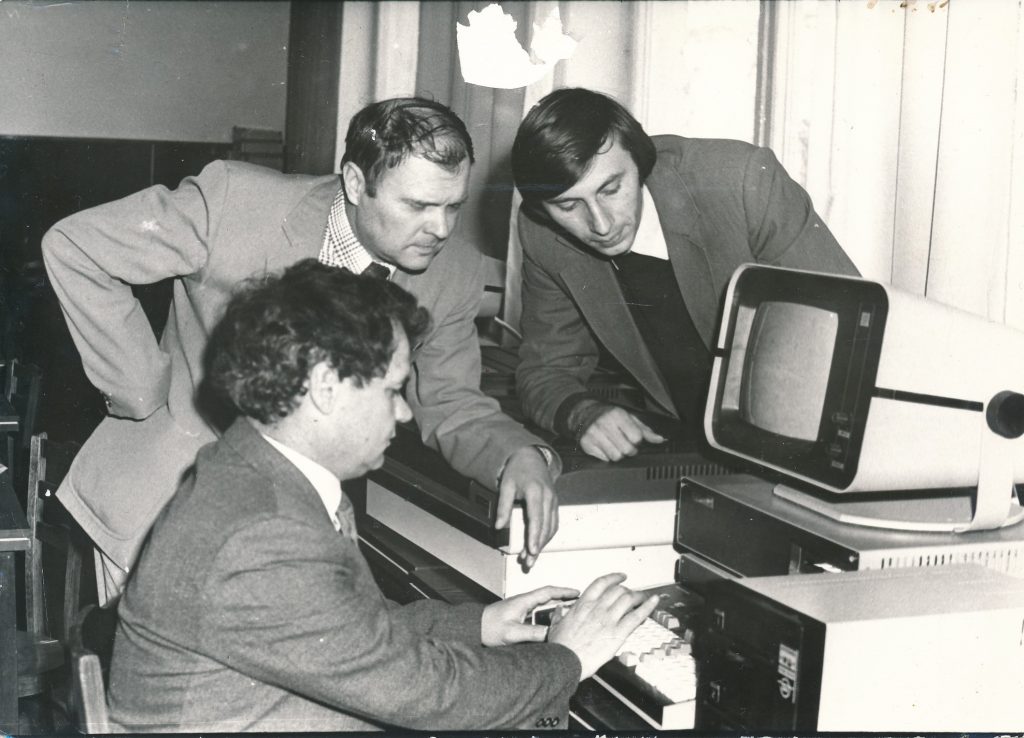
Professors Iu. Marcov, PhD, associate professor, M. Botoșanu, senior lecturer, L. Chiriac, assistant, tests the first computers in the State Pedagogical Institute in Tiraspol
Initially, the following members were part of the department: Iulian Marcov, PhD, associate professor; Iurie Camarov PhD associate professor; Alexei Hapco, senior lecturer; Mihail Botosanu, senior lecturer; Liubomir Chiriac, assistant; Mila Salinschi, assistant; Valentina Banari, lecturer; Nadejda Ratiner, programmer engineer; Svetlana Tacu, laboratory assistant. Since its foundation and until 30 April 2005, the CSCT Department’s work was coordinated by Iulian Marcov PhD in physical and mathematical sciences, associate professor.
It should be noted that already in December 1985, there was a DBK-2 computer laboratory in TSU. And in January 1986 there were two computer rooms in operation. In 1986, the CSCT Department organizes one of the first union conferences at Computer Science. At that conference, the best specialists in the field from various centres were present: Kyiv, Moscow, Odessa, Chisinau, etc.
In the spring of 1992, the CSCT
Department already had 6 well-equipped computer laboratories: two laboratories with
DBK-2 computers; two laboratories with computers of Japanese Yamaha production;
two laboratories with American-made computers.
4. The activity of the Computer Science and Information Technologies Department within Tiraspol State University evacuated to Chisinau
Because of the Transnistrian war, in June, the year 1992, the CSCT Department, together with the collective of the Tiraspol State University was evacuated to Chisinau. For well-known reasons, all the laboratories, equipment, technical means, and teaching materials produced by the members of the department remained in Tiraspol. The CSIT Department lacked the material and scientific basis and had to go through new attempts to restore it. Professors of the CSIT Department found themselves facing a new beginning. In Chisinau, the Department changed its name to the Computer Science and Information Technologies Department and restarted its scientific-methodical activity, setting up and relaunching practically all the computer laboratories necessary to ensure the training and research process.
From 1 May 2005 to 16 February 2010, the Head of the CSIT department was Andrei Braicov, PhD in physical and mathematical sciences, Associate Professor, a graduate of the Tiraspol State University.
From 17 February 2010 to date, the Head of the CSIT Department is Liubomir Chiriac, PhD in physical-mathematical sciences, university professor, graduate of the University of State University of Tiraspol.
Currently in the CSIT Department activates:
- Liubomir Chiriac, Doctor Habililtatus, University Professor, Head of CSIT Department;
- Andrei Braicov, PhD, Associate Professor, Dean of Faculty, FMTI;
- Angela Globa, PhD, Associate Professor, vice-rector;
- Dorin Pavel, PhD, Associate Professor; Head of the TSU typography;
- Ala Gasnas, PhD, Associate Professor;
- Maria Pavel, PhD, Associate Professor;
- Teodora Vascan, PhD, Associate Professor;
- Natalia Josu, PhD, Associate Professor;
- Natalia Lupasco, PhD, Associate Professor; Head of the Creative Artificial Intelligence Laboratory;
- Tatiana Veverita, EdD, Associate Professor; Head of the Information Technologies Centre;
- Inga Titschiev, PhD, Associate Professor; Director, Institute of Mathematics and Computer Science;
- Sergiu Corlat, PhD, Associate Professor;
- Lilia Mihalache, PhD, Associate Professor;
- Olga Cerbu, PhD, Associate Professor;
- Violeta Bogdanova, PhD student;
- Aurel Danilov, PhD student;
- Vasile Galben, chief programmer engineer;
- Ana Racovita (Mihalache), secretary, senior laboratory assistant, CSIT department;
- Dumitru Rugaliov, assistant engineer.
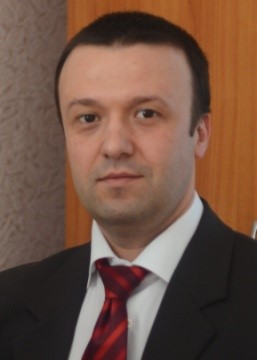
Andrei Braicov, PhD, Associate Professor, Dean of Faculty, FMTI
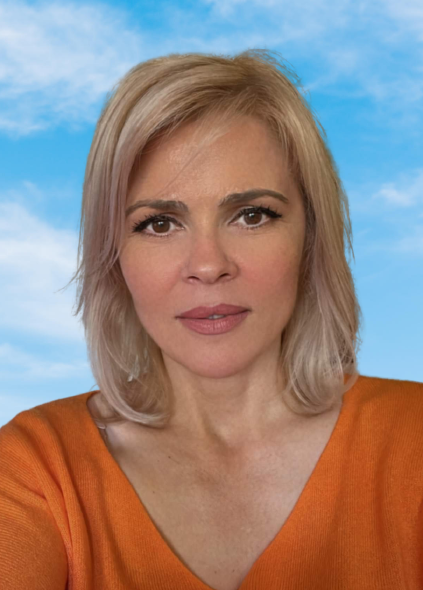
Tatiana Veverita, EdD, Associate Professor; Head of the Information Technologies Centre
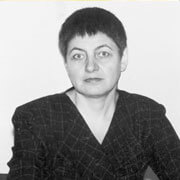
Natalia Josu, Ph.D., associate professor
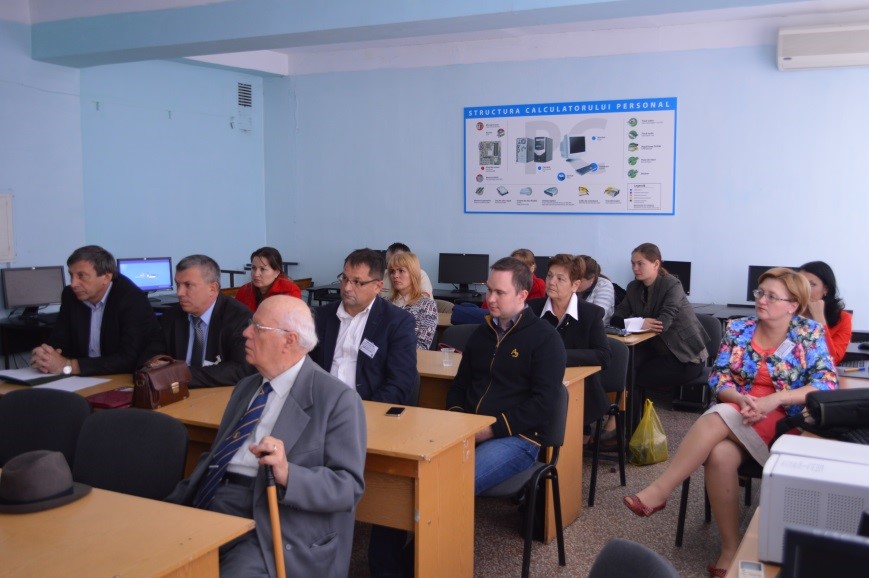
The CSIT department is constantly coming up with proposals for updating courses in the IT field for students. Currently, students in I academic cycle (bachelor) study the following Computer Science courses:
- Operating Systems and Computer Architecture;
- Fundamentals of Programming, Pascal language;
- Programming in Medium-Level Programming Languages, C language;
- Object-Oriented Programming, C++ language;
- Educational Robotics;
- Assembly Languages;
- Databases;
- Web Technologies;
- Programming Techniques;
- Graph Theory;
- Petri Nets;
- Programming Language Prolog;
- Artificial Intelligence;
- Genetic Algorithms;
- Programming Language JavaScript;
- Design and Analysis of Algorithms;
- Computer Assisted Graphics;
- Numerical Methods;
- Stochastic Processes;
- Mathematical Software;
- Didactics of Informatics;
- Computer Networks;
- Formal Languages.
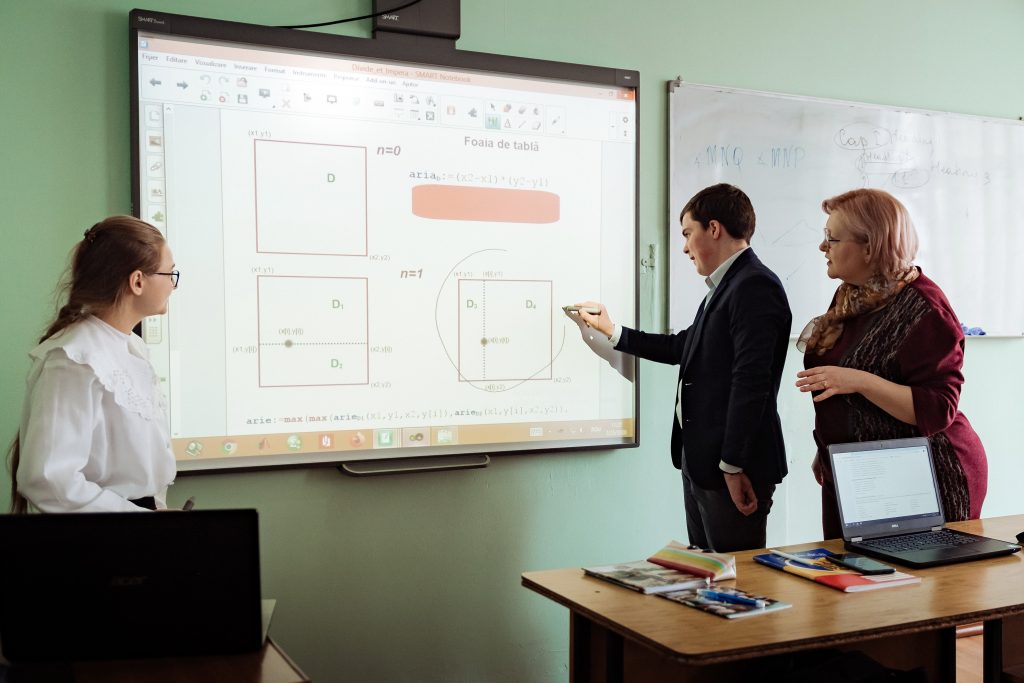
The subjects of the second cycle (Master) are taught only by professors with scientific and teaching degrees. During the two years of Master’s studies the following courses are taught:
- Advanced Web Technologies;
- Cryptography;
- Distributed Systems;
- Logical Methods in AI/ Digital Skills for Teachers;
- Algebraic Structures on the Computer;
- Recursion Theory;
- Methodology of Study Computer Science from the Perspective of STEAM;
- Java Programming language;
- C# Programming Language;
- Research Methods and techniques in ICT;
- Advanced Visual Programming;
- Testing of Programming Products;
- Information Security;
- Development of Skills of creation open educational resources;
- Statistical Processing of Psych-pedagogical Information.
Currently, the CSIT Department has 8 modern computer rooms connected to the Internet, printers, scanners, video cameras, etc., in which teaching activities are carried out training of future specialists. The department provides training to students in the following specialities:
- Computer Science;
- Computer Science and Mathematics;
- Computer Science and Physics;
- Mathematics and Computer Science;
- Physics and Computer Science;
- Geography and Computer Science.
Also, within the Department CSIT, there are three scientific laboratories, properly organized and equipped with state-of-the-art equipment, that provide an environment conducive to scientific and educational research:
- Information Technologies Laboratory “Prof. Doctor Iulian Marcov”;
- Laboratory “Creative Artificial Intelligence”;
- Laboratory “Algorithms and Programming. Cyber”.
The CSIT professors are highly qualified specialists, successfully working in the fields of Computer Science and Didactics of Informatics. As a confirmation, there are more than 1000 scientific and didactic publications, including monographs, university, and pre-university textbooks, and guides for teachers, produced by the collaborators of the department.
The scientific activity of the academic staff involved in the teaching process is focused on the following areas:
I. Algorithms on the application of Petri nets and graphs in solving practical problems. Development of software applications realized on various technologies.
II. Theoretical and applied substantiation regarding the study of formal sciences in the educational system of Moldova from inter/transdisciplinary perspective (STEAM); Robotics and Artificial Intelligence.
III. Development of algorithms for solving complex problems in computational mathematics including abstract algebra. Studying algebraic structures on the computer.
Due to the specific nature of higher education work, in the CSIT department, absolutely all members of the department are involved in the research process. A brief feature of research directions is outlined below:
- Algorithms on the application of Petri nets and graphs in solving practical problems
The research topics are:
- Analysis of modelling power of the Petri nets formalism workflow for modelling purposes both the hardware component and the software component of a system and developing mechanisms to translate systems with parallel processes into Petri nets workflows;
- Elaboration of the algorithm for the determination of a template area from an image, which will allow database searches (in particular with ultrasonographic medical images) to detect certain specific features;
- Adjustment and adaptation of the Petri net method, extending the output system by adding time for the problem of social disasters;
- Carrying out quantitative and qualitative analysis of the evacuation system of people from rooms, using generalized stochastic Petri nets;
- Development of technologies, products, and information systems.
- Petri net non-timed models. Procedural control of discrete event systems.
- Petri net models with deterministic timing and stochastic timing.
Some publications and doctoral theses
defended on the research topics listed above, are:
- Titchiev I. Modelling of the movement of human flows in the process of evacuation from multi-story buildings by Hierarchical Petri Nets. In: Proceedings of the Conference on Mathematical Foundations of Informatics, MFOI’2018, July 2-6, 2018, Chisinau, Republic of Moldova, p. 259-264. ISBN 978-9975-4237-7-9.
- Titchiev I. Quantitative analysis of the evacuation system utilizing Generalized Stochastic Petri nets. In: Computer Science Journal of Moldova, vol. 24, no. 2(71). Kishinev, 2016. p. 184-191.
- Pelin N., Pelin S. Program. Logic in the design of information systems. Chisinau: TSU, 2011. 221 p.
- PhD thesis: Camerzan I. Structural properties of Time Petri nets. PhD thesis in computer science. Chisinau, 2007.
2. Theoretical and applied substantiation regarding the study of formal sciences in the educational system of Moldova from inter/transdisciplinary perspective (STEAM)
Research topics include:
- The impact of ICT on initial training of pre-university philological teachers;
- The use of LMS technologies for teaching-learning-assessing of OOP;
- The use of LMS and LCMS technologies in the teaching-learning-assessment process of OOP in higher education;
- Use of new Information Technologies in the process of assessment in computer science;
- ICT pre-acquisitions and post-acquisitions, necessary for the initial training of primary school teachers;
- Integration of competencies – a factor of quality assurance of professional training of university graduates;
- Methodical approaches to the implementation of new information technologies in the process of studying the subject “Programming Techniques”.
Some publications, and doctoral theses, defended on the abovementioned topics, are:
- Globa A. Methodology of implementation of new Information Technologies in the process of studying the university subject “Programming Techniques”. Chisinau: University State University of Tiraspol, 2018. 172 p. ISBN 978-9975-76-236-6.
- Gasnaș, A. Methodology of implementation of Learning Management Systems in the process of studying Programming Oriented Programming. Chisinau: State University of Tiraspol, 2019. 176 p. ISBN 978-9975-76-278-6.
- Gremalschi A., Corlat S., Braicov A. Digital education. The second grade: Teaching support for students and teachers. Chisinau, 2019. Multimedia edition. 72 p.
- Vascan T. Study of new technologies from the perspective of functionality in the educational process. In: Acta et Commentationes. Sciences of Education. Scientific journal No. 2(16), 2019. Chisinau: Tiraspol State University, 2019. p.115-122. ISSN 1857-0623.
- Chiriac L., Mihălache L. The methodology for preparing undergraduate students for Olympiad in informatics in extended format. In: Acta et Commentationes, Sciences of Education, scientific journal, No. 4(18), 2019, ISSN 1857-0623, E-ISSN 2587-3636, p.37-45.
- PhD theses:
- Mihalache L. Methodical approaches to the application of complex computational technologies in the teaching-learning process of the “Modelling and computational methods” section in the high school computer science course. PhD thesis in pedagogical sciences. Chisinau, 2013.
- Pavel M. Initial training of future teachers through the use of information and communication technologies. PhD thesis in pedagogical sciences. Chisinau, 2015.
- Globa A. Methodical approaches to the complex implementation of new information technologies in the teaching-learning-evaluation process of the university subject “Programming Techniques”. PhD thesis in pedagogical sciences. Chisinau, 2016.
- Gasnas A. Methodology of implementation of learning management systems in the process of study of object-oriented programming. PhD thesis in Pedagogical sciences. Chisinau, 2018.
- Vascan T. Developing professional skills in computer science based on optimal correlation of mathematics and informatics contents. Thesis Doctor of Pedagogical Sciences. Chisinau, 2018.
- Veverița T. Methodology for the digital competence development in the process of initial training of philological teachers. PhD thesis in pedagogical sciences. Chisinau, 2019.
III. Development of algorithms for solving complex problems in computational mathematics including abstract algebra. Studying algebraic structures on the computer
The research topics are:
- Development of algorithms for the identification of algebraic properties of finite order groupoids;
- Investigation of special direct products of quasigroups of a certain type;
- Generation of quasigroups of finite order;
- Investigation of isomorphism of finite order groupoids;
- Solving computational geometry problems;
- Algorithms for solving special differential equations;
- Development of encryption algorithms based on algebraic structures;
- Application of quasigroups to the development of encryption systems.
Among the most relevant publications and PhD theses defended on these topics are:
- Chiriac L. Algebraic structures on the computer. Chisinau: Central Typography, 2014. 60 p. ISBN 978-9975-53-301-0.
- Corlat S. Algorithms and computational geometry problems. Chisinau: Prut International Publishing House, 2009. 76 p. ISBN 978-9975-69-377-6.
- Лупашко Н. Коммутативные лупы Муфанг с некоторыми условиями минимальности. Chisinau: Tiraspol State University, 2017 (UST Typography). 103 p.
- Chiriac L., Danilov A., Lupasco N., Josu N. On non-isomorphic quasigroups of small order, CAIM, 2018, 20th-23rd September. Chisinau: Technical University of Moldova, 2018. p. 87 – 88.
- Bobeica N., Chiriac L. A method for constructing medial and non-paramedial quasigroups. In: Journal Acta et Commentationes, Exact and Natural Sciences Series, no. 2(4) 2017. Chisinau: TSU, 2017. ISSN 2537-6284.
- PhD theses:
- Braicov A. GL (2, R) – orbits of systems of differential equations and applications. PhD thesis in physical-mathematical sciences. Chisinau, 2002.
- Pavel D. Almost periodic applications on topological spaces. PhD thesis in physical-mathematical sciences. Chisinau, 2009.
- Chiriac L. Topological-algebraic systems and their applications. Doctor Habilitatus thesis in physical-mathematical sciences. Chisinau, 2011.
- Josu N. Investigation of topological groupoids with multiple units. PhD thesis in mathematical sciences. Chisinau, 2015.
- Lupașco N. Commutative Moufang loops with minimal conditions of finiteness. PhD thesis in mathematical sciences, 2018.
The CSIT Department professors, based on the research carried out on the above-mentioned topics, successfully guide the students of computer science majors in the realization of bachelor’s and master’s theses.
All CSIT Department professors have been or are involved in research and expertise activities in the following national and international projects:
- Tempus Structural Project No. 145035-TEMPUS-2008-LT-JPTHN WETEN (Western-Eastern Teacher EducationNetwork), 2009 – 2011.
- Tempus IV Project. TEREC (Teacher Education Review and Update of Curriculum), 2010 – 2013.
- Tempus IV Project QUAEM (Development of Quality Assurance in Higher Education in Moldova Consortium),2012 – 2014.
- Erasmus+ Project TEACH ME (Creating Moldovan E-network for promoting innovative e-teaching in the continuing professional education), 2015 – 2018.
- Institutional Project Computer-assisted continuing education methodologies of mathematics and computer science teachers, 2015 – 2019.
- NATO SPS project G5437 WITNESS (Wide InTegration of sensor Networks to Enable Smart Surveillance), 2018 – 2020.
- Methodology of ICT implementation in the study process of real sciences in the education system of the Republic of Moldova from the perspective of inter/transdisciplinarity (STEAM concept).
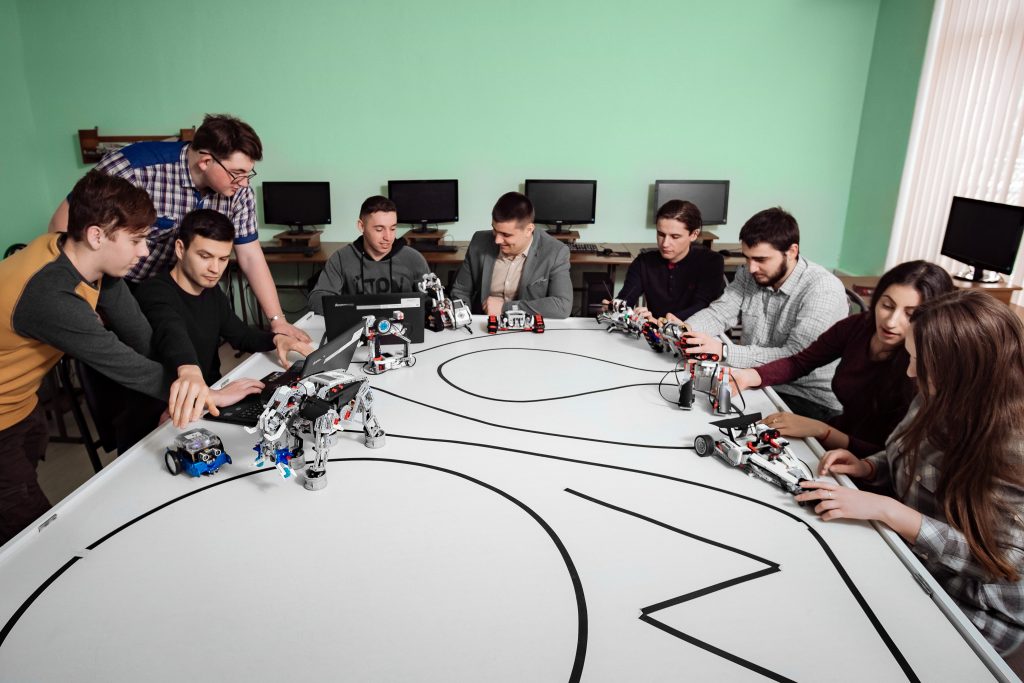
The department collaborates on international projects with various national and international academic institutions, among which we signal:
- Kaunas Institute of Technologies (Lithuania);
- Royal Institute of Technology in Stockholm (Sweden);
- University of Hasselt (Belgium);
- University of Aveiro (Portugal);
- New University of Lisbon (Portugal);
- TimSoft from Timisoara (Romania);
- Pedagogical University of Krakow (Poland);
- University of Craiova (Romania);
- University of Genoa (Italy).
The CSIT Department, during its 37 years of activity, has made a remarkable contribution to the achievement of national priorities, through the implementation of projects focusing on education and training, as well as by carrying out numerous studies and research.
Trends and perspectives of development
Currently, all members of the CSIT Department are involved in the implementation of the project “ Methodology of ICT implementation in the study process of real sciences in the education system of the Republic of Moldova from the perspective of inter/ transdisciplinarity (STEAM concept)“, within the State Programmes 2020- 2023. In this context, are developed, or in the process of elaborating a series of scientific-didactic works that are missing in the educational system of the Republic of Moldova.
Within this project, CSIT Department professors are collaborating with teachers from other departments in TSU, executive members of the project, with whom they carry out joint interdisciplinary research.
The collaborators of the department have contributed and continue to be actively involved in the training of scientific and teaching staff as highly qualified teachers. Thus, under the scientific direction of Professor Liubomir Chiriac, the following researchers defended their doctoral thesis: Teodora Gherman, Lilia Mihalache, and Margarita Nijegorodova, Natalia Josu, Angela Globa, Natalia Lupașco, Lidia Popov. And under the direction of Associate Professor Andrei Braicov, have defended their doctoral thesis Tatiana Velicova, lecturer at the University of Comrat, Ala Gasnas, Tatiana Veverita.
The CSIT Department coordinates the activity of the scientific-didactic seminar “Informatics and didactics of informatics”. The members of the CSIT Department also had a major role in founding the scientific journal “Acta et Commentationes”, with its two series: Sciences of Education and Exact and Natural Sciences, as members of editorial boards and authors of publications.
Thus, we mention with great pleasure the successes achieved by our teachers in the development of studies, the level of a large number of papers, and the promising start of our young researchers who were in their first study.
